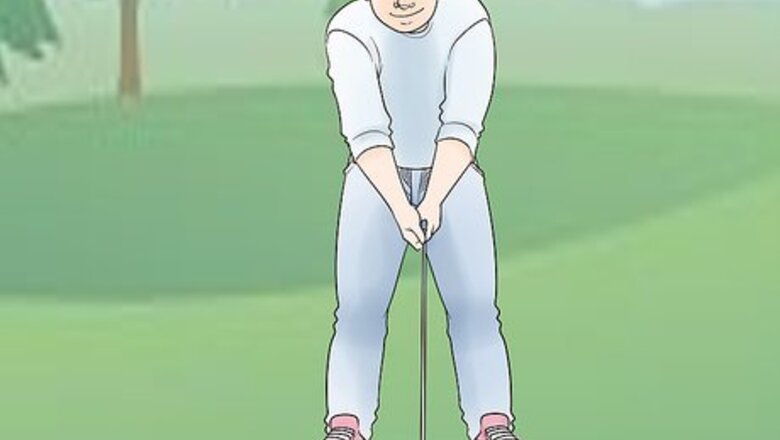
views
- Stand about 3 steps behind the ball with your feet shoulder-width apart. Then, grip the driver firmly by placing one hand directly below the other.
- Swing the driver in an arc behind your head. Shift your weight to your front foot and swing the driver back down, extending your arms as you swing.
- Twist your body to follow the driver’s arc down. Then, follow through by bringing the driver over your front shoulder.
Positioning Yourself Near the Ball
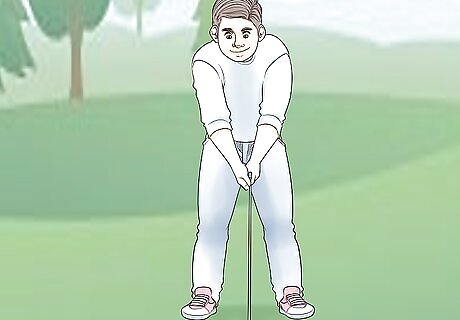
Stand beside the ball with your weaker hand closer to the target. Choose the side you want to swing from, then face the ball. If you are right-handed, stand on the left side of the ball. Point your left shoulder towards the target. If you are left-handed, stand to the right of the ball with your right shoulder pointed towards the target. The half of your body closest to the target is your front side, such as your front arm and leg. Is This half is most important for aiming and driving the ball forward. The half furthest from the target is your back or rear side. This half is responsible for your backswing and generating power.
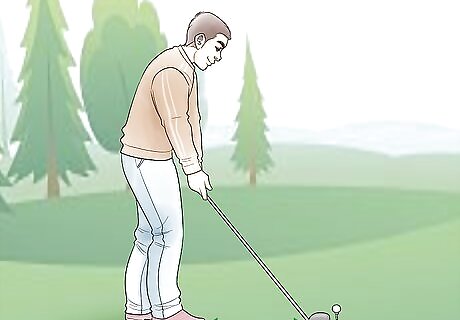
Position yourself about 3 steps behind the ball. Walk backwards from the ball if you are unsure where to stand. When hitting the ball, you will need to bend over slightly. If this feels uncomfortable, you can move closer or further from the ball as needed. You should be able to see the top of the ball without standing over it. If your head is directly over the ball, you will have a hard time generating a smooth, powerful swing. If you stand too far away from the ball, you will have to stretch your arms further to hit the ball, weakening your drive.
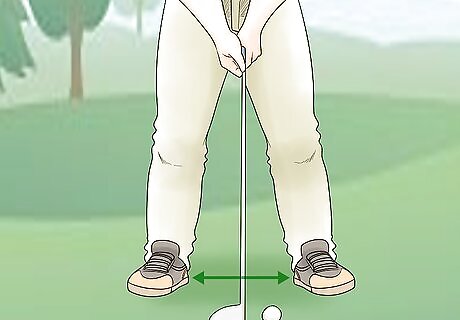
Spread your legs apart with your knees bent slightly forward. Stand beside the ball, spacing your legs about a shoulder width apart. The ball should be positioned a little behind the inside part of the heel on your front leg. This means the ball will be much closer to your front leg than your back leg. A wider stance means you will swing the driver in a wider arc. This can throw off your timing, so keep your feet relatively close together at first. Focus on getting your stance correct before bringing the club into position. Once you have mastered this, you can do both simultaneously to improve your aim..
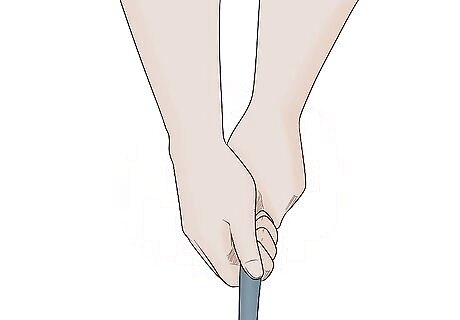
Grip the driver firmly with 1 hand below the other. This grip is called the overlap grip and is beginner-friendly. Position your back hand on the driver’s grip. Then, place your front hand above it, resting 1 or 2 fingers over your lower hand. Adjust your grip until it feels comfortable and balanced, neither tight nor loose. An interlocking grip is when you cross your index finger and pinkie. This is a good grip for fast swings and anyone with smaller hands. A 10-finger grip is like holding a baseball bat. Your fingers do not overlap. It can be good if you lack strength, but it leads to less powerful drives.
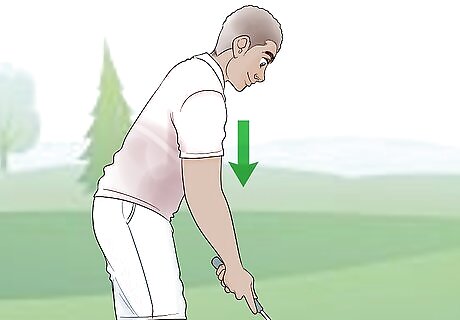
Bend at the hips to bring your head towards the ball. Plant your feet firmly on the ground so they stay in position. Slowly bend forward, keeping your back and neck straight. Your head should come forward so you are able to look diagonally down to your club’s head and the top of the ball. Your back and neck should be flat. If your spine is bent at all, you may tire out and get sore while playing. The ball should line up with your front ear, although your ear will be behind the ball instead of over it.

Tilt your body to raise your forward shoulder. Twist forward and towards your front leg. Bring the club around so it is near the tee. This should cause your front hip and shoulder to raise up. You want your front side to be slightly higher than your back side. To get yourself in position, you may shift your weight to your back leg. If you are having trouble getting the angle correct, take your back hand off the club. Put it behind your rear knee to lower your shoulder, then put it back on the driver grip again.
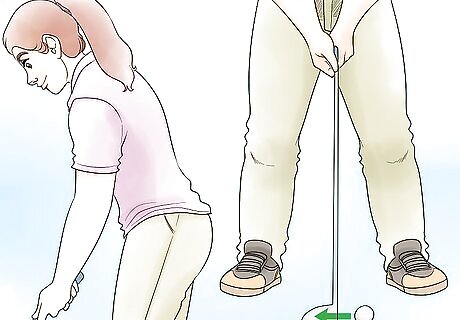
Drop your shoulders to position the club behind the ball. Position the club head so it is centered behind the ball. Let your shoulders hang down, then pull them back slightly. This should make your arms feel firm, ready to control a steady swing. If you feel like you can’t swing the club freely, adjust your positioning as needed by stepping back or standing straighter. This position causes the head of the driver to strike the ball on the upswing, lifting it off the tee. Balance is key. Make sure your weight is evenly distributed in both legs.
Driving the Ball
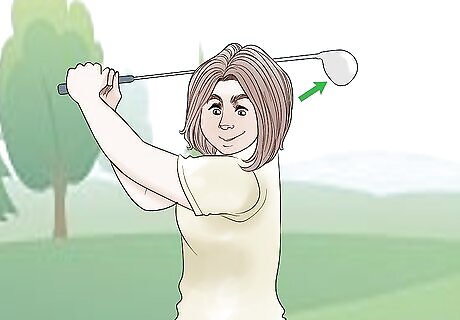
Sweep the club’s head back in an arc until it is behind your head. Start your swing in your abdomen, tightening the muscles there as you begin moving the club towards your back leg. Keep your hands in position with your feet flat on the ground. Continue moving the club in an arc until the shaft is behind the middle part of your head. Keep your leading, or front, arm straight the entire time so you don’t have to straighten it out on the downswing. Generate power by shifting your weight to your back leg as you swing.
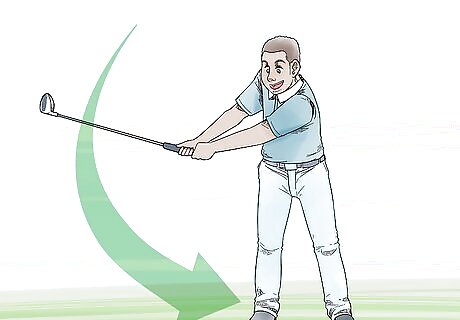
Swing the driver down to begin your downstroke. Start the downswing by slightly pushing your front knee and hip towards the ball. Shift your weight from your back foot to your front foot, keeping both feet flat on the ground. Avoid adjusting your arms during the swing. Swing the club back down in a arc like it’s a pendulum. Avoid rushing the swing. You can let the club settle briefly over your shoulders before you begin the downswing. The goal is to swing smoothly rather than hit the ball as hard as you can.
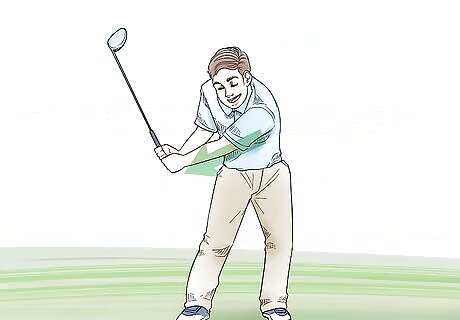
Extend your arms as you swing. Your front arm should still be straight like it was during your backswing. Straighten your rear arm as you bring the club around. Both of your arms become completely straight when the club reaches the ball. Focus on keeping your arms straight as long as possible after hitting the ball.
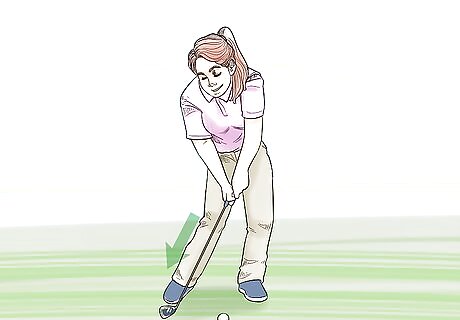
Push your feet down into the ground as you strike the ball. Right before the club reaches the ball, shift your weight fully to your front leg. Imagine that you are squishing a giant bug underneath your toes. This can help you transition your weight smoothly from back to front, generating more power. The key is to do this in a smooth motion. You may need to practice your swing before you can do this without thinking. For extra speed, shift your front foot away from the ball as you swing.
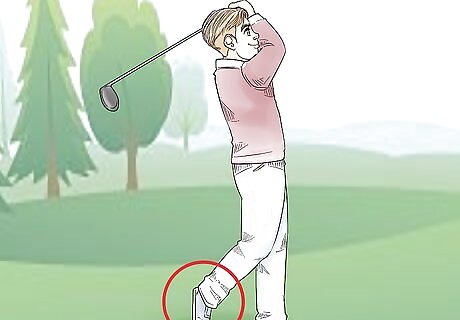
Lift and turn your rear foot after you hit the ball. As you shift your weight to your front leg, try to keep your back foot on the ground as long as possible. After the club strikes the ball, twist your ankle so your back leg follows the rest of your body. When done correctly, your back foot will point forward with only the toes touching the ground. As you twist your foot around, the rest of your body also continues to twist, following your club’s swing.
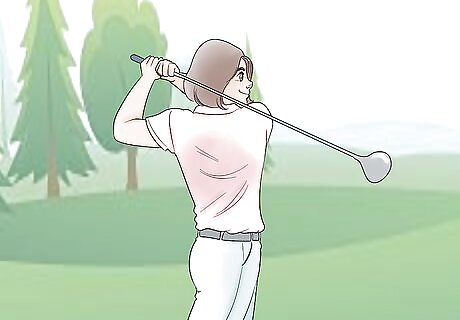
Follow through by bringing your club over your front shoulder. Avoid stopping your swing short, since this causes shorter, weaker drives. Bring the club’s head all the way through the ball. Continue the arc of the swing until the club comes up over your shoulders. At the end, the club’s head should point down towards the ground. At the end of your swing, your arms will be bent into the shape of a capital “L.” Your back arm will be near your head with your front arm behind it. Stay relaxed during your follow-through. Tensing up causes the ball to veer to the left or right.
Troubleshooting Your Swing
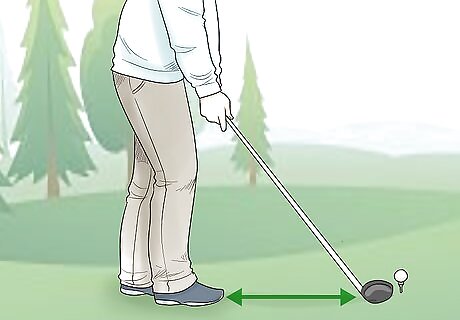
Stay balanced to swing with an average amount of power. One of the most basic issues is trying to hammer the ball to hit it long distances. This ends up reducing your power because you aren’t swinging properly. Check your swing mechanics to ensure your feet and hands are balanced. Then, swing steadily without attempting to make power adjustments. For example, make sure your feet are flat on the ground with your weight balanced between them. If your swing is too light, the ball won’t travel very far. Your hands and shoulders may be too loose. Remember, the goal is to swing the club smoothly and make contact, not smash the ball. You may lose a little distance at first, but consistency makes up for it over time.
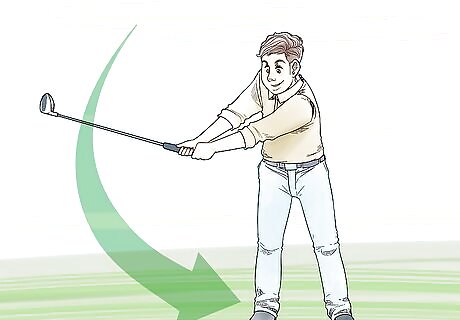
Swing the driver at a steady speed. A lot of beginning golfers face a swing speed problem. They start a normal upswing, but rush the downswing. This interrupts the natural flow of your swing, so you hit weaker balls that tend to curve all over the golf course. Practice your swing until you can do it in a single, fluid motion. Although the basic mechanics are the same, not all golfers have the same swing. You may need to experiment a little to find out what feels natural to you. A common problem is hesitating as you begin the downswing. Other golfers may tell you you’re swinging too fast when in reality the hesitation makes your swing look faster than it is.
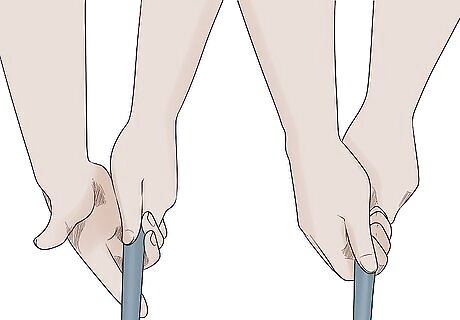
Adjust your hand grip to hit the ball straighter. For a good swing, your grip strength needs to be equal across both hands. Keep a firm grip on the driver, but avoid squeezing it too hard. If your front hand grip is too strong, the ball will hook. If your back hand grip is too strong, the ball will slice. A hook is when the ball curves inwards towards your body. This is right to left for right-handed golfers and left to right for left-handed golfers. A slice is when the ball curves away from your body, or left to right for right-handers and right to left for left-handers.
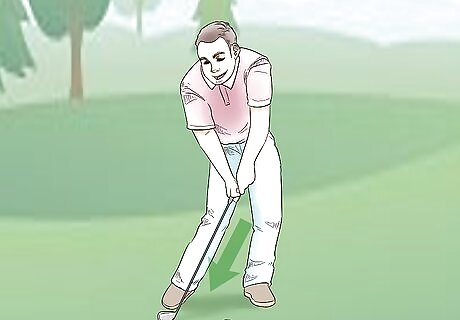
Straighten your swing to avoid hooks and slices. If your grip strength is fine, your swing mechanics may be an issue. First of all, make sure your legs, hips, and shoulders are straight while swinging. Swing through the ball with a consistent speed, since slowing down or speeding up can cause hooks and slices, respectively. Your club’s head should face upward as it snaps into the ball. Experiment with which part of the club’s head strikes the ball, since this affects the curve. Although you can adjust your aim to compensate for a curving ball, fixing your swing mechanics is a better long-term solution. If you are certain your swing is good, moving the tee forward or adjusting your distance to it can help.

















Comments
0 comment